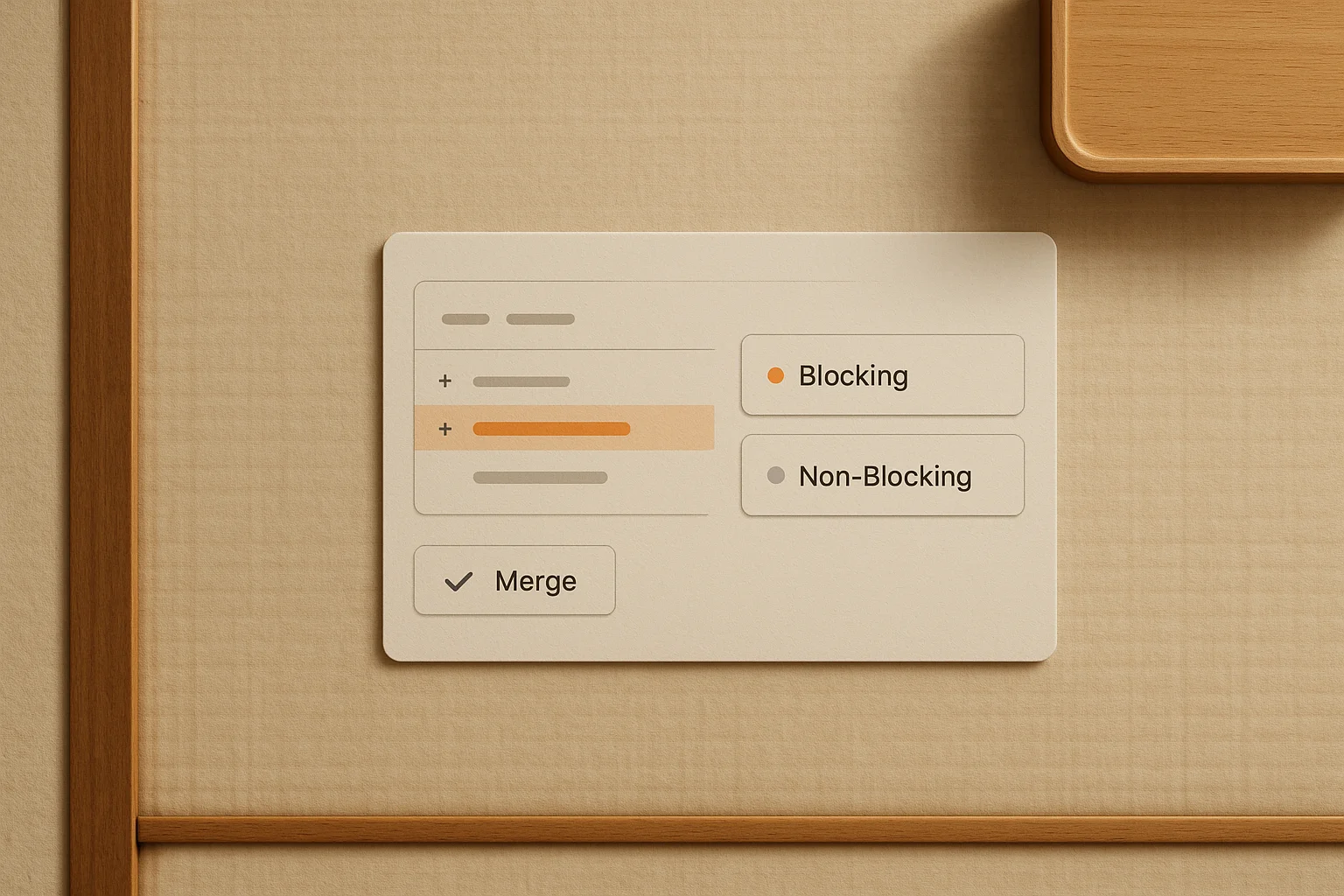Blocking vs. Non-Blocking Code Review Comments: Definitions, Examples, and Automation

Quick answer
Blocking code review comments describe issues that must be fixed before a pull request merges. Non-blocking comments call out optional improvements, clarifications, or follow-up tasks. High-velocity teams label the difference explicitly, then rely on tools like Propel Code to classify severity, track follow-through, and keep blockers from being merged accidentally.
Review comment tone drives how fast a pull request ships. Without a shared definition, developers treat every note as a must-fix or ignore them entirely. This guide explains how to define blocking versus non-blocking feedback, how to document expectations in policy, and how Propel Code enforces those rules automatically so quality stays high without slowing the team.
Blocking vs. non-blocking comments at a glance
| Comment type | What it signals | Owner responsibility | Propel Code guardrail |
|---|---|---|---|
| Blocking | Code violates policy, breaks behaviour, or introduces risk. | Must resolve or explicitly override before merge. | Blocks the merge queue until the comment is marked resolved or waived by policy. |
| Non-blocking | Improvement idea, nit, or follow-up suggestion. | Acknowledges suggestion. May defer with follow-up issue or comment agreement. | Tracks acceptance rate and pushes reminders when suggestions pile up. |
Set the vocabulary before the code review
The easiest way to create friction is to let reviewers invent their own severity scale. Add the definitions to your team guide, include examples, and describe how to acknowledge each type. Teams using lightweight review checklists increase merge confidence because authors understand which comments block the release.
Propel Code bakes this into policy. Comment classification runs on every pull request and enforces that blocking feedback requires a follow-up commit or an override from the right owner. The system alerts reviewers if they close a conversation without an associated fix or waiver, so the vocabulary stays meaningful over time.
When to flag a comment as blocking
- Policy violations: Security, compliance, or branch protection rules are not met. Propel Code checks the policy catalog and prevents accidental approval.
- Correctness issues: A bug, failing test, or undefined behaviour slips through. Blocking the merge protects production integrity.
- Missing context: If requirements, rollout plans, or dependencies are unclear, a blocking comment forces the author to document the reasoning.
- Risky architectural changes: Large migrations or rewrites need senior sign-off. Propel Code routes the pull request to the right reviewers when the risk score spikes.
Blocking should never feel like a personal attack. It is a signal that standards are being upheld. Provide objective evidence, reference the policy, and propose a path to resolution. If the author disagrees, escalate synchronously rather than waging an async debate in the comments.
Non-blocking comments that still drive improvement
Non-blocking feedback keeps the conversation collaborative. Use it to share alternative patterns, mention ideas for future iterations, or reinforce positive practices. Readers looking for more examples can skim our guide on interpreting nit comments. When you label a suggestion as non-blocking, explicitly acknowledge if you plan to tackle it now or later.
Propel Code tracks how often reviewers accept non-blocking suggestions. Analytics surface whether certain topics (naming, logging, test coverage) require a policy upgrade. If a non-blocking comment keeps reappearing, convert the pattern into a checklist item or lint rule instead of relying on human memory.
Non-blocking feedback also captures mentorship moments. Senior engineers can leave context about tradeoffs without halting the release. Propel Code stores these conversations with the pull request record, making it easy to revisit when planning training or onboarding content.
Design a workflow that respects both comment types
- Tag comments with severity: Prefix blocking notes with
[blocking]or use built-in review labels. Propel Code adds severity tags automatically and displays them in the PR sidebar. - Automate reminders: Schedule daily summaries of outstanding blockers so no one waits until standup to discover the release is stuck.
- Define override authority: When a deadline looms, make it clear who can approve a risky change. Propel Code policies require a documented exception with a Jira or Linear ticket number before proceeding.
- Capture follow-up tasks: For non-blocking ideas, create issues or add them to the team backlog. Propel Code can open tickets automatically for repeated themes.
Sample comment templates your team can adapt
Blocking: failing edge case
[blocking] This change skips the null check we rely on for partner integrations. Reproduce by sending an empty payload to /api/v2/batch. Please restore the guard or update the integration tests before merging. Propel Code flagged this as high risk.
Non-blocking: style consistency
Non-blocking: consider using the shared useRetryableFetch hook. It keeps metrics consistent. I will create a follow-up ticket if we prefer to defer. Propel Code marked this suggestion as low impact.
Propel Code automations that keep blockers honest
Propel Code acts as the system of record for review feedback. Comment classifiers and policy rules work together to stop risky merges even if someone accidentally hits Approve. Authors see a real-time checklist with every blocking thread, and the merge button stays disabled until each item is resolved or waived.
The platform also ships an audit trail. Leaders can export a report that shows how many blockers were raised, how quickly they were resolved, and which teams introduced the high-risk changes. This is invaluable when preparing for security reviews or compliance audits.
Finally, Propel Code integrates with Slack and Microsoft Teams to broadcast unresolved blockers. Instead of refreshing the pull request, engineers receive a digest showing what is left to address and who is responsible. Teams regain hours of flow time each sprint.
Checklist before merging
- Every blocking comment references the policy, test, or requirement it protects.
- Non-blocking ideas have a clear follow-up owner or ticket link.
- The author replied to each thread so nothing slips through silent resolution.
- Propel Code shows zero unresolved blockers and a healthy risk score.
- Release notes mention any deferred items so they are visible to stakeholders.
FAQ: blocking vs. non-blocking comments
How do we decide if feedback is blocking or non-blocking?
Start with impact. Blocking feedback ties directly to correctness, security, or policy coverage. Non-blocking notes highlight polish, future refactors, or optional learning. Propel Code surfaces the difference automatically by tagging each thread with severity and reminding the author which ones must be resolved before merge.
What should we do when a blocking comment can't be fixed immediately?
Pause the merge until the risk is mitigated. That can mean addressing the feedback, shipping a compensating change, or filing a follow-up ticket with a clear owner and due date. Propel Code enforces this flow by requiring a linked issue during override and logging the exception for audit trails.
Can non-blocking comments still slow the release?
Yes—especially when suggestions stack up without acknowledgment. Ask authors to reply with “will fix now” or “follow-up filed,” and use Propel Code dashboards to track acceptance rates so optional work doesn't silently pile up.
How does Propel Code classify severity?
The platform runs comment classifiers on every pull request, mapping language cues to blocking, must-fix, or informational buckets. Reviewers can adjust the label, and those decisions train future recommendations. The merge check stays red until every blocking thread is resolved or waived by policy.
How do external contributors learn the scale?
Document the definitions in your public contribution guide and include comment templates in pull-request templates. Propel Code keeps the experience consistent by tagging incoming feedback—even from first-time contributors—with the same severity rules your maintainers use.
End Guesswork with Automated Comment Severity Tracking
Propel Code classifies every review comment, escalates unresolved blockers, and enforces merge policies so feedback never slips through the cracks.


